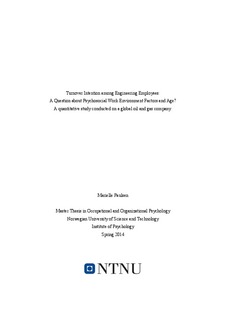Turnover Intention among Engineering Employees: A Question about Psychosocial Work Environment Factors and Age?: A quantitative study conducted on a global oil and gas company
Master thesis
Permanent lenke
http://hdl.handle.net/11250/271276Utgivelsesdato
2014Metadata
Vis full innførselSamlinger
- Institutt for psykologi [2884]
Sammendrag
Background and purpose: The main goal was to examine which factors in the psychosocial work environment that would predict turnover intention among engineering employees in a larger global company within the oil and gas industry. The second goal was to examine if the predictors would differ for employees under the age of 40, compared to employees over the age of 40.
Method: Data was collected using a self-reported electronic questionnaire designed by Mille Myhre and myself. The analyses included three control variables and seven independent variables, which also encompassed a new aspect of the psychosocial work environment research in relation to turnover intention, namely the personal resources optimism and selfefficacy. The questionnaire was distributed through an e-mail sent from the Vice President HSE, and a sample of 128 participants was used in the analyses conducted in SPSS.
Key findings: The predictors were job satisfaction, leadership and sickness absenteeism, and were found to have different rank of importance for the employees in the two age groups, regarding the predictor’s beta value. Optimism and self-efficacy were not found as predictors of turnover intention in the current sample.
Conclusion: To manage the employee’s turnover intention the leaders should focus on the employee’s satisfaction with their work, keeping a high qualitative transactional leadership and be observant to the employee’s sickness absenteeism, but control for the employee’s age if they were to initiate actions to control for turnover intention.
